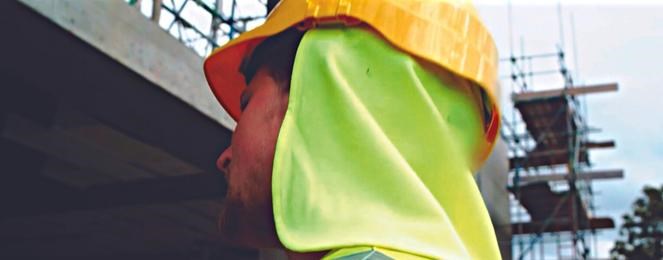Five Ways Tech is Boosting Health, Safety & Wellbeing
The cost of injuries for construction workers across the UK has reached more than a staggering £16.2 billion a year. However, there are now more ways...
Read Full Article
It’s lovely for a holiday but the heatwave could cause severe sunburn leading to cancer a workplace safety and health body has warned.
The Institution of Occupational Safety and Health (IOSH) warns that sun exposure causes 99% of non-melanoma skin cancer and up to 65% of malignant melanoma skin cancer – and yet vulnerable outside workers, particularly those employed in construction, remain ignorant of the dangers.
For example, research into sun exposure in the UK construction sector, commissioned by IOSH from Nottingham University, showed that two thirds of those working outside for an average of seven hours a day either thought they were not at risk or didn’t know whether they were or not.
Nearly 60% of construction workers reported having sunburn at least once in the past year, while 40% thought there was no need to wear sunscreen on a cloudy day (up to 80% of UV rays can penetrate clouds).
No protection
Most of those surveyed said they didn’t take measures to protect themselves against sun exposure and neither workers or managers saw sun safety as a critical issue, mainly due to the misperception that the UK climate doesn’t pose a high risk of skin cancer.
Death
Other research, commissioned by IOSH from Imperial College London, found that around 50 people die each year in the UK from skin cancer caused by sun exposure at work, with 240 new cancer cases being registered annually.
“The majority of those affected are men and just under half of those diagnosed with malignant melanoma linked to sun exposure at work are under 65, findings which are echoed in studies around the world, including North America, Australia and Europe.”
– Ruth Wilkinson
Head of health and safety, IOSH
One in three
“At least 1,500 new cases of work-related non-melanoma skin cancer (more treatable than malignant melanoma) are also registered each year in Britain, with 12 deaths,” Wilkinson continues.
Between two and three million non-melanoma skin cancers and 132,000 melanoma skin cancers occur globally each year. One in every three cancers diagnosed is a skin cancer.
As well as sunburn, Ultraviolet (UV) exposure can also cause premature aging of the skin, a range of vision-impairing eye conditions and weakening of the immune system.
Not a jolly holiday
“This heatwave maybe perfectly timed for a holiday but the reality is that the risks to sun-protected holiday-makers aren’t comparable to the risks faced by millions of outdoor workers, who for significant periods of the year are typically exposed to solar radiation for hours at a time, day in, day out,” adds Wilkinson.
“It should also be born in mind that these workers often have long term, chronic solar radiation exposure to particular areas of the body, such as their head, neck, arms and hands, with legs and torso also being exposed on particularly hot days.
“The fact remains that in some industry sectors, the risks still aren’t acknowledged or managed as well as they could be.”
How to manage it
Here’s an IOSH checklist to help manage outdoor workers’ exposure to the sun - 90% of skin cancer deaths could be prevented if exposure to UV is controlled:
Be sure to check the UV index from the weather forecast and communicate information to relevant workers.
Try to minimise exposure to direct sunlight until at least 3:00pm, if possible.
Regularly swap job tasks between workers to ensure everyone in the team can spend some time in the shade.
Erect heavy duty outdoor cover or shade – shade can cut UV exposure by 50-plus%.
Make sure rest breaks are taken in shaded areas or indoors.
Encourage the wearing of long-sleeved, loose-fitting tops and trousers when working outside during months with high UV levels.
Wear wide-brimmed hats that shade the face, head, ears and neck. Where safety helmets are worn, use those fitted with ‘Legionnaire-style’ neck flaps.
Wear sunglasses with 100% UV protection or use UV-filtering safety goggles with the same level of protection if the work requires physical eye protection.
Don’t rely on sunscreen alone for protection.
Encourage workers to regularly check their skin for changes such as moles or other skin differences. Detecting the early signs of skin cancer and undergoing early treatment can save lives.
Picture: Heatwave alert - sun can blind workers to skin cancer threat.
Article written by Cathryn Ellis
11th July 2022